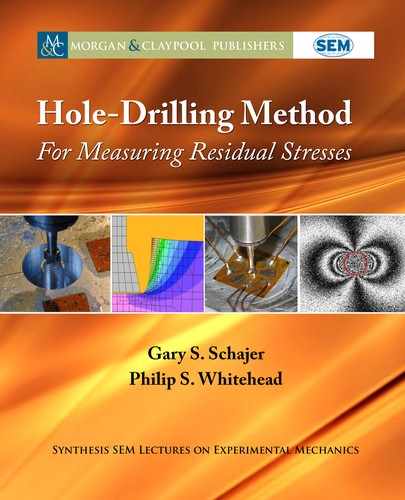
110 5. STRESS COMPUTATIONS
0.5
0.4
0.3
0.2
0.1
0.0
1.0
0.8
0.6
0.4
0.2
0.0
0 1 42 3 0 1 42 3
Specimen ickness (W/a)
Calibration Constant a_bar
Calibration Constant b_bar
Specimen ickness (W/a)
h/a = 1.00
0.75
0.25
0.50
h/a = 1.00
0.75
0.25
0.50
Figure 5.13: Variation with specimen thickness of the calibration constants Na and
N
b in an “in-
termediate” thickness specimen. h D hole depth, W D specimen thickness, a D hole radius
(adapted from Schajer and Abraham (2014)).
5.8.4 HOLE ECCENTRICITY CORRECTION
e numerical values of the calibration matrices
N
a and
N
b are determined for the ideal case where
the hole is exactly centered within the hole-drilling rosette used for the measurements, equally
distant from each strain gauge. Commercial rosettes are made with prominent alignment marks
and hole drilling devices include specially designed observation microscopes, both to assist with
accurate hole placement. However, despite these precautions, it may sometimes happen that
a hole is cut slightly off-center. In this case, the strain gauges are at unequal distances from
the hole, with the nearer ones showing elevated readings and the more distant ones showing
diminished readings. ese strain variations distort the computed residual stresses.
e effect of hole eccentricity is purely geometrical, so if the size and position of the
eccentricity are accurately known, the effect can be fully compensated mathematically. Practical
methods have been proposed by Sandifer and Bowie (1978), Beghini (2010), and Ajovalasit
(1979), among others. However, great care has to be taken when seeking to correct for hole
eccentricity. e correction procedures can be effective only when the size and position of the
eccentricity actually are accurately known. It they are not, then the “correction” has the possibility
of doing more harm than good. Certainly, the most effective action is to take great care to
align the drill accurately during equipment setup and thereby minimize the possibility of hole
eccentricity errors.
5.8.5 PLASTICITY EFFECTS
When doing hole-drilling residual stress measurements, the drilling of the hole creates a stress
concentration in the material around the hole. In a case where the original residual stresses are
..................Content has been hidden....................
You can't read the all page of ebook, please click here login for view all page.
